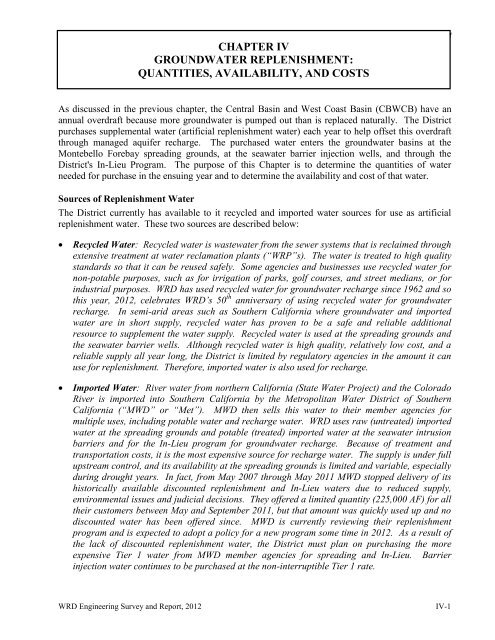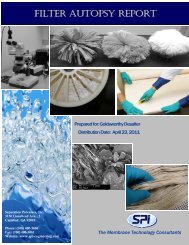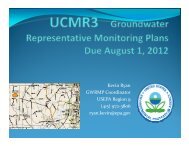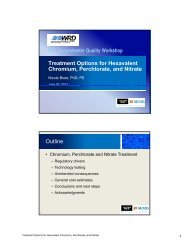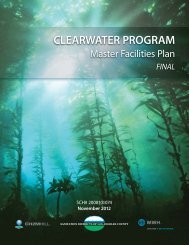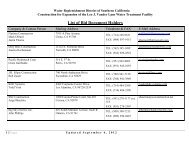Download pdf - Water Replenishment District of Southern California
Download pdf - Water Replenishment District of Southern California
Download pdf - Water Replenishment District of Southern California
You also want an ePaper? Increase the reach of your titles
YUMPU automatically turns print PDFs into web optimized ePapers that Google loves.
CHAPTER IV<br />
GROUNDWATER REPLENISHMENT:<br />
QUANTITIES, AVAILABILITY, AND COSTS<br />
Groundwater <strong>Replenishment</strong><br />
As discussed in the previous chapter, the Central Basin and West Coast Basin (CBWCB) have an<br />
annual overdraft because more groundwater is pumped out than is replaced naturally. The <strong>District</strong><br />
purchases supplemental water (artificial replenishment water) each year to help <strong>of</strong>fset this overdraft<br />
through managed aquifer recharge. The purchased water enters the groundwater basins at the<br />
Montebello Forebay spreading grounds, at the seawater barrier injection wells, and through the<br />
<strong>District</strong>'s In-Lieu Program. The purpose <strong>of</strong> this Chapter is to determine the quantities <strong>of</strong> water<br />
needed for purchase in the ensuing year and to determine the availability and cost <strong>of</strong> that water.<br />
Sources <strong>of</strong> <strong>Replenishment</strong> <strong>Water</strong><br />
The <strong>District</strong> currently has available to it recycled and imported water sources for use as artificial<br />
replenishment water. These two sources are described below:<br />
<br />
<br />
Recycled <strong>Water</strong>: Recycled water is wastewater from the sewer systems that is reclaimed through<br />
extensive treatment at water reclamation plants (“WRP”s). The water is treated to high quality<br />
standards so that it can be reused safely. Some agencies and businesses use recycled water for<br />
non-potable purposes, such as for irrigation <strong>of</strong> parks, golf courses, and street medians, or for<br />
industrial purposes. WRD has used recycled water for groundwater recharge since 1962 and so<br />
this year, 2012, celebrates WRD’s 50 th anniversary <strong>of</strong> using recycled water for groundwater<br />
recharge. In semi-arid areas such as <strong>Southern</strong> <strong>California</strong> where groundwater and imported<br />
water are in short supply, recycled water has proven to be a safe and reliable additional<br />
resource to supplement the water supply. Recycled water is used at the spreading grounds and<br />
the seawater barrier wells. Although recycled water is high quality, relatively low cost, and a<br />
reliable supply all year long, the <strong>District</strong> is limited by regulatory agencies in the amount it can<br />
use for replenishment. Therefore, imported water is also used for recharge.<br />
Imported <strong>Water</strong>: River water from northern <strong>California</strong> (State <strong>Water</strong> Project) and the Colorado<br />
River is imported into <strong>Southern</strong> <strong>California</strong> by the Metropolitan <strong>Water</strong> <strong>District</strong> <strong>of</strong> <strong>Southern</strong><br />
<strong>California</strong> (“MWD” or “Met”). MWD then sells this water to their member agencies for<br />
multiple uses, including potable water and recharge water. WRD uses raw (untreated) imported<br />
water at the spreading grounds and potable (treated) imported water at the seawater intrusion<br />
barriers and for the In-Lieu program for groundwater recharge. Because <strong>of</strong> treatment and<br />
transportation costs, it is the most expensive source for recharge water. The supply is under full<br />
upstream control, and its availability at the spreading grounds is limited and variable, especially<br />
during drought years. In fact, from May 2007 through May 2011 MWD stopped delivery <strong>of</strong> its<br />
historically available discounted replenishment and In-Lieu waters due to reduced supply,<br />
environmental issues and judicial decisions. They <strong>of</strong>fered a limited quantity (225,000 AF) for all<br />
their customers between May and September 2011, but that amount was quickly used up and no<br />
discounted water has been <strong>of</strong>fered since. MWD is currently reviewing their replenishment<br />
program and is expected to adopt a policy for a new program some time in 2012. As a result <strong>of</strong><br />
the lack <strong>of</strong> discounted replenishment water, the <strong>District</strong> must plan on purchasing the more<br />
expensive Tier 1 water from MWD member agencies for spreading and In-Lieu. Barrier<br />
injection water continues to be purchased at the non-interruptible Tier 1 rate.<br />
WRD Engineering Survey and Report, 2012<br />
IV-1


